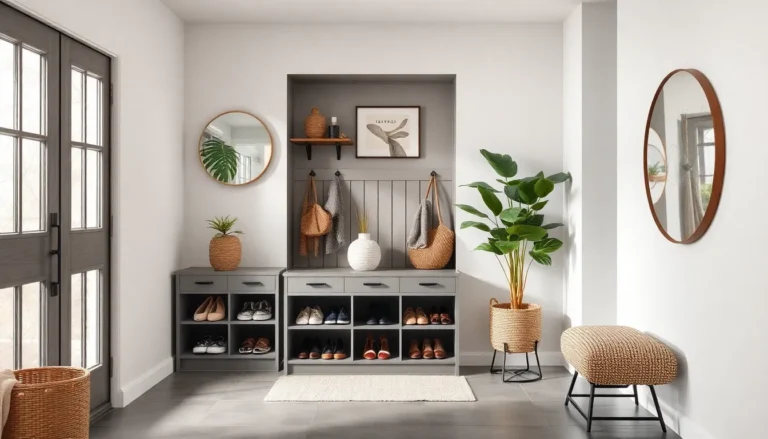In today’s world, the living room isn’t just a space to plop down after a long day; it’s the heart of the home, a sanctuary for relaxation, and a stage for hosting friends. Modern interior design takes this concept to a whole new level, blending style with comfort in ways that’ll make anyone want to kick off their shoes and stay awhile.
Table of Contents
ToggleOverview of Modern Interior Design Living Room
The modern interior design of a living room emphasizes open spaces that promote both comfort and function. Sleek furniture pieces often feature clean lines and minimalistic designs, allowing for an uncluttered appearance. Natural materials like wood, metal, and stone play a crucial role, creating a warm and inviting atmosphere.
Color palettes lean towards neutral tones, enhancing serenity and allowing for versatile decor options. Accent colors can make a bold impact, introducing personality and vibrancy without overwhelming the space. Lighting elements contribute significantly to the ambiance; strategically placed fixtures highlight key areas while maintaining a cozy feel.
Layouts prioritize flexibility, accommodating various activities, from entertaining guests to enjoying personal downtime. Sectional sofas provide ample seating while fostering conversation, establishing an engaging environment. Additionally, integrating technology seamlessly into the design elevates convenience and modernity.
Accessories serve both aesthetic and practical functions. Decorative pillows and throws add comfort and style, while shelves provide storage solutions that blend with the overall decor. Artwork and plants introduce elements of creativity and life, enhancing visual interest without straying from the modern theme.
Sustainability has gained traction in modern living room designs. Eco-friendly materials not only resonate with contemporary values but also contribute to overall well-being. Choices ranging from sustainable furniture to energy-efficient lighting reflect a commitment to mindful living and design.
Ultimately, the modern interior design of a living room encapsulates a balance of style, comfort, and functionality, creating spaces that promote well-being and meaningful interactions.
Key Elements of Modern Design

Modern interior design emphasizes several key elements that shape the living room experience. These components create a harmonious and functional space, making it inviting and stylish.
Color Palette
Neutral color palettes define modern living rooms. Shades like gray, beige, and white build a serene backdrop. Accent colors, such as bold blues or vibrant greens, inject personality. Choose these colors for textiles, art, or decor, maintaining balance throughout the space. Darker hues may also ground the design, providing depth and drama. This careful selection cultivates a soothing atmosphere, encouraging relaxation and connection.
Furniture Selection
Sleek, minimalistic furniture is essential for modern design. Each piece reflects clean lines and functional forms without excessive ornamentation. Sofas and chairs prioritize comfort while retaining an elegant appearance. Encourage diversity in materials, mixing natural wood with metal or glass accents. Multi-functional furniture contributes practicality, such as ottomans that serve storage needs. Prioritizing quality over quantity ensures a curated aesthetic that avoids clutter.
Lighting Options
Effective lighting dramatically influences the living room’s ambiance. Natural light should be maximized, using large windows or skylights where possible. Layered lighting combines ambient, task, and accent options, creating depth. Pendant lights, floor lamps, and wall sconces craft distinct zones, enhancing the space’s versatility. Dimmer switches offer flexibility, allowing adjustments for various activities. Thoughtful lighting choices not only elevate design but foster a welcoming environment.
Popular Modern Styles
Modern interior design offers diverse styles that cater to various tastes and preferences. These styles emphasize simplicity, functionality, and aesthetics, making them popular choices for living rooms.
Minimalism
Minimalism prioritizes simplicity and functionality in living room design. Clean lines and uncluttered spaces define this style, creating a serene atmosphere. Furniture pieces display sleek forms and often lack ornamentation. Color palettes tend to be neutral, with occasional pops of color for contrast. A few carefully chosen accessories enrich the minimalistic theme without compromising the open feel. Natural materials like wood and stone enhance warmth while maintaining a fresh, airy vibe.
Industrial
Industrial style incorporates raw materials and an unfinished look, typical of urban lofts. Exposed brick walls and metal fixtures serve as focal points in this aesthetic. High ceilings and large windows contribute to an open, spacious feel. Furniture often showcases reclaimed wood and steel elements, emphasizing sustainability and uniqueness. Color schemes lean toward earthy tones paired with darker accents. This style celebrates imperfections, integrating vintage elements that add character and charm.
Mid-Century Modern
Mid-century modern design reflects timeless elegance and functionality. This style features organic shapes and an integration of indoor and outdoor spaces. Bright colors and bold patterns often enliven upholstery and decor. Iconic furniture pieces, like the Eames lounge chair, are essential, showcasing craftsmanship and style. Wood tones remain warm, creating a welcoming environment. Overall, mid-century modern spaces prioritize comfort while maintaining a stylish and sophisticated aesthetic.
Tips for Designing a Modern Living Room
Designing a modern living room involves thoughtful planning and stylish details. A focus on functionality and aesthetics creates a welcoming environment.
Space Planning
Effective space planning enhances both flow and comfort. Prioritize furniture arrangements that encourage conversation by placing seating in clusters around focal points, such as a fireplace or TV. Use multi-functional pieces, like ottomans with storage capabilities, to maximize utility while minimizing clutter. Allow for ample pathways to maintain an open feel, enabling easy movement within the room. Incorporating area rugs can delineate spaces, providing visual boundaries without obstructing flow. Position larger furniture items against walls to expand usable space in the center.
Accessorizing
Accessorizing adds personality and warmth to the modern living room. Select artwork that resonates with the room’s theme, ensuring it complements existing color palettes. Use decorative pillows and throws to introduce texture and comfort, while keeping patterns cohesive. Incorporate plants for a touch of nature; they enhance air quality and infuse vibrancy. Lighting fixtures, such as stylish floor lamps or pendant lights, can serve as both practical tools and statement pieces. Ensure accessories maintain a balance between aesthetics and functionality, enriching the overall design while reflecting personal style.
Modern interior design transforms the living room into a vibrant space that fosters connection and comfort. By blending style with functionality it creates an inviting atmosphere that encourages social interaction and relaxation.
The thoughtful integration of materials colors and lighting enhances the overall experience while reflecting personal tastes. With a focus on sustainability and multi-functional elements modern living rooms not only cater to aesthetic preferences but also promote well-being.
As design trends continue to evolve embracing these principles will ensure that living rooms remain dynamic hubs of the home.



